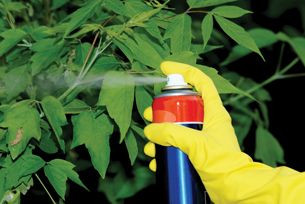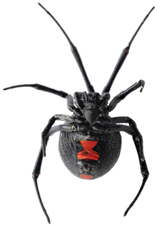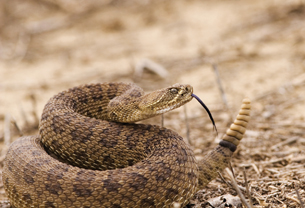Module 1
1. Module 1
1.54. Page 3
Module 1—The Nervous System
Reabsorption of Neurotransmitters
 Read
Read

© Robert Rozbora/shutterstock
Why don’t neurotransmitters continue to start new nerve impulses over and over again? This normally does not happen because the neurotransmitter is transported back into the presynaptic neuron, or it is broken down by enzymes and the fragments are moved back into the synaptic knob. For example, if the neurotransmitter is acetylcholine, the enzyme cholinesterase breaks it down and the fragments are reabsorbed into the synaptic knob. Scientists have created insecticides that bind up cholinesterase, causing acetylcholine to stay in the synapse and continually stimulate the muscles until they become fatigued and no longer contract. The insect dies because it can no longer contract muscles to get oxygen into its body. If the neurotransmitter is norepinephrine, it is reabsorbed directly into the presynaptic neuron. You can review what happens to the neurotransmitter by reading pages 380 and 382 in your textbook. Take notes as you read, and add this information to your course folder.
acetylcholine: one of the most common neurotransmitters of both the somatic nervous system and the parasympathetic nervous system
Acetylcholine functions by binding to receptors on the postsynaptic membrane and either depolarizing or hyperpolarizing the membrane.
cholinesterase: an enzyme necessary to decompose acetylcholine in the synaptic cleft so that the products (choline and ethanoic acid) can be reabsorbed by the presynaptic membrane; also called acetylcholinesterase
 Self-Check
Self-Check
To ensure that you understand the events that occur in synaptic transmission, answer the following questions. If you do not understand any part of synaptic transmission, or have any questions or concerns, discuss them with your teacher. Remember to phrase your answers in complete sentences using correct biological terminology. Consult the suggested answers for examples. Store your completed answers in your course folder.
SC 1. Summarize the events involved in impulse transmission, starting at the presynaptic neuron and ending at the postsynaptic neuron.
SC 2. Identify the function of neurotransmitters in the nervous system.
SC 3. Place the following events in the correct sequence.
- An action potential is initiated in the dendrite.
- Neurotransmitters are released into the synaptic cleft.
- Sodium gates are opened and sodium ions rush into the dendrite.
- A wave of depolarization arrives at the axon terminal.
SC 4. Deadly neurotoxins produced by some organisms, such as the rattlesnake and black widow spider, could have medical implications. One neurotoxin found in rattlesnake venom blocks receptors on postsynaptic neurons. Venom from the female black widow spider stimulates exocytosis of synaptic vesicles from neurons. Speculate how these neurotoxins might affect the body, and suggest a possible medical use for each of them.

© Miles Boyer/shutterstock

© Sly/401055/Fotolia
SC 5. Explain what happens to the neurotransmitters once an action potential has been started in the postsynaptic neuron.
 Self-Check Answers
Self-Check Answers
SC 1. The following events summarize, in correct sequence, the events involved in impulse transmission from the presynaptic neuron to the postsynaptic neuron.
- A wave of depolarization arrives at the axon terminal.
- Synaptic vesicles fuse with the presynaptic membrane.
- Neurotransmitters are released from the vesicles into the synaptic cleft.
- Neurotransmitters diffuse to the postsynaptic membranes and lock into complementary receptors.
- Sodium gates are opened and sodium ions rush into the postsynaptic neuron or dendrite of the second neuron.
- An action potential is initiated in the postsynaptic membrane of the dendrite.
- Neurotransmitters are decomposed by enzymes and reabsorbed by the presynaptic membrane.
SC 2. The function of neurotransmitters in synaptic transmission is to carry the neural signal from one neuron to another. Neurotransmitters can also carry the neural signal from a neuron to an effector, such as a muscle cell. Because the neurotransmitters can only be formed in the synaptic knob of the axon terminals, and neurotransmitter receptor sites are only located on the postsynaptic membrane, one-way impulse transmission is assured.
SC 3. The correct sequence of events is d, b, c, and a.
SC 4. One neurotoxin from rattlesnake venom blocks receptors on postsynaptic neurons. Venom from the female black widow spider stimulates exocytosis of synaptic vesicles from neurons. If a neurotoxin blocks receptors on postsynaptic neurons, as in the rattlesnake venom, it could prevent the binding of the neurotransmitter acetylcholine, thereby blocking the transmission of a nerve impulse to the muscle and causing muscle paralysis. If the impulse is a result of a negative stimulus, such as pain, blocking it could be effective in medical treatment. If a neurotoxin increases the release of neurotransmitters, as in the spider venom, it could also result in nerve and muscle fatigue and be useful in preventing transmission of pain impulses.
SC 5. If the neurotransmitter is acetylcholine, the enzyme cholinesterase (found in the synaptic cleft) decomposes the acetylcholine and the smaller fragments are reabsorbed by the presynaptic membrane. If the neurotransmitter is noradrenaline, it is reabsorbed directly.
SC 6. To review the anatomy of the synaptic gap and the functions of the structures, do this structures and functions drag-and-drop activity. Match the term with the number on the diagram, and match the function with the structure. Check your answers, and then file your work in your course folder.